Out of all the features owls have, their eyes are one of the most prominent ones. Large owl eyes are great for seeing in the dark, taking up to 5% of the total body weight in some species.
Unlike human eyes who can move in different directions, owl eyes are fixed within their sockets – they can only look straight ahead! Lots of owl species have larger eyes than humans with 10 to 100 times better vision than ours.
Examples of owls with big eyes include the short-eared owl, long-eared owl, snowy owl, barn owl, barred owl, burrowing owl, cape eagle-owl, spotted eagle-owl, and many others.
Here are their photos and some fun facts.
Table of Contents
Owls With Big Eyes
Eurasian Eagle-owl
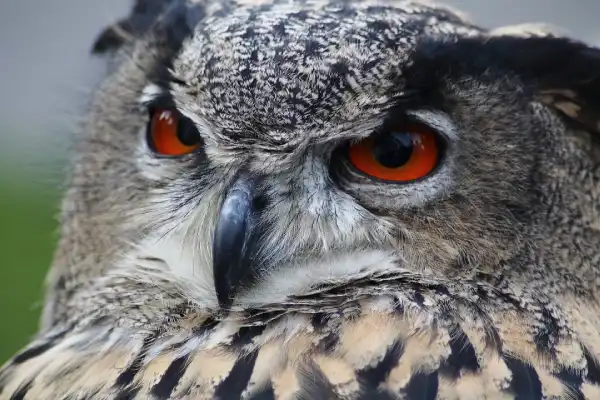
- Scientific Name: Bubo bubo
- Length: 22-30 in
- Wingspan: 51.5-74 in
- Weight: 2.6-10.1 lb
Eurasian eagle-owls are huge and powerful owls found in Europe and Asia, in various habitats ranging from forests to rocky canyons.
They are also called the Uhu and have very pronounced ear tufts, mottled upperparts, barred wings, and streaked underparts.
Eurasian eagle-owls also have pumpkin-orange eyes that make them one of the most striking owls in the world.
They are among the largest species of owls and apex predators; they hunt at night using their acute hearing to locate their prey and feed on small mammals, birds, fish, insects, and reptiles.
Pairs are vocal and will often sing in a duet, exchanging a series of deep and high-pitched hoots.
Barn Owl
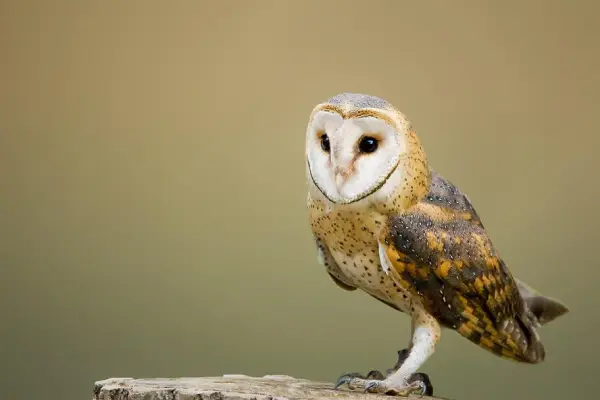
- Scientific Name: Tyto alba
- Length: 13-15 in
- Wingspan: 31-37 in
- Weight: 9-19 oz
One of the most widely distributed species of owl in the world, barn owls are highly elusive raptors found around open fields, riparian areas, and farms.
These medium-sized owls have a “ghostly” appearance due to their heart-shaped heads, cinnamon and gray upperparts, and white underparts.
Barn owls also have deep dark eyes with a large binocular field of view – the axial length (from front to the back of the eye) of their eyes is about 3/4 of that of human eyes (0.68 in vs. 0.96 in).
Barn owls do not hoot and make bone-chilling screams instead. They hunt for rodents during the night and roost in nest boxes, caves, tree hollows, and old buildings.
They are quite common in the USA and can be seen in southern California, northern California, east Tennessee, west Washington, etc.
Read More: More examples of black-eyed owls
Barred Owl
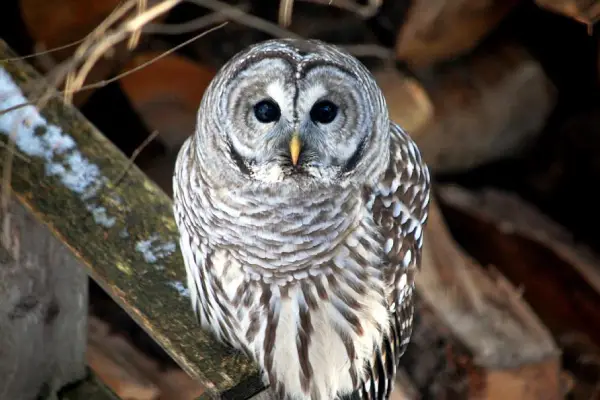
- Scientific Name: Strix varia
- Length: 16-25 in
- Wingspan: 38-49 in
- Weight: 1.3-2.5 lb
Known under several names (northern barred owls, striped owls, or more informally, hoot owls), barred owls are large birds with mottled brown and white plumage.
They can be identified by their yellow beaks, absence of ear tufts, and hoots that sound like “who cooks for you, who cooks for you all” and can be heard almost half a mile away.
Barred owls have large and dark brown, almost black eyes.
They are native to eastern North America and found mostly around woods and swamps where they hunt for insects, small mammals, crayfish, and crabs.
Southern White-faced Owl
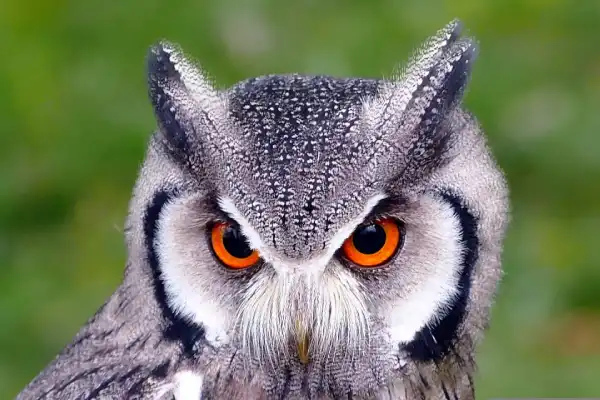
- Scientific Name: Ptilopsis granti
- Length: 8.7–11 in
- Wingspan: 26.7 in
- Weight: 6.5-7.8 oz
Southern white-faced owls are small owls native to southern Africa. They can be identified by their gray backs, pale underparts, and large ear tufts.
Southern white-faced owls also have large orange-red eyes on their distinctive black-and-white faces.
These owls inhabit savannas and dry woodlands where they hunt for large insects, birds, reptiles, and small mammals.
Southern white-faced owls will often make a quick series of “hu” calls followed by a longer “hwooow”.
Great Horned Owl

- Scientific Name: Bubo virginianus
- Length: 17-25 in
- Wingspan: 35-60 in
- Weight: 2.7-3.5 lb
With a wingspan of almost 5 feet, length of almost 2 feet, and weight of up to 3.5 pounds, great horned owls are among the largest owls in North America.
These aggressive raptors have gray-brown plumage with a mottled pattern, long earlike tufts, and deep hooting calls.
Great horned owls also have enormous and intimidating bright yellow eyes that are only slightly smaller than ours.
Compared to other owls, great horned ones have eyes that are larger in proportion to their brains – they also have large pupils that constrict or dilate to help see in different light conditions.
These owls have one of the most diverse diets of all North American raptors and can feed on rabbits, hares, rats, mice, voles, other small mammals, larger mid-sized mammals, reptiles, amphibians, and invertebrates.
Typically well-camouflaged, great horned owls are never easy to spot in the wild.
Burrowing Owl
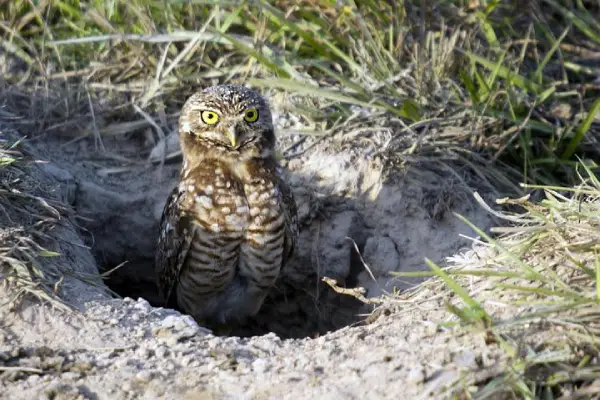
- Scientific Name: Athene cunicularia
- Length: 7-11 in
- Wingspan: 20-24 in
- Weight: 5-8 oz
Burrowing owls are small long-legged birds of prey. They are the only owl species that nest underground and can be identified by their brown plumage, wings with white spots, white bellies, and no ear tufts.
Burrowing owls have big bright eyes that are 100 times more sensitive to light than human eyes.
These owls are common around open areas with no trees, including grasslands, rangelands, agricultural areas, and deserts; unlike most owls, they are active during the day when they hunt insects and small mammals.
Burrowing owls are also one of several birds that are native to Florida.
Eastern Screech Owl

- Scientific Name: Megascops asio
- Length: 6.3-10 in
- Wingspan: 18-24 in
- Weight: 4-8 oz
Eastern screech owls are small and stocky owls with big heads, large yellow eyes, often-raised small ear tufts, and horn-colored beaks.
They are found in eastern parts of North America, in different habitats with trees and near water.
Eastern screech-owls are easier to hear than to see – they are most active at night when they hunt insects, small mammals, and birds. Their big eyes and sharp vision come in very handy for picking up small movements at night.
These owls are one of the most common birds found in northern Georgia.
Snowy Owl
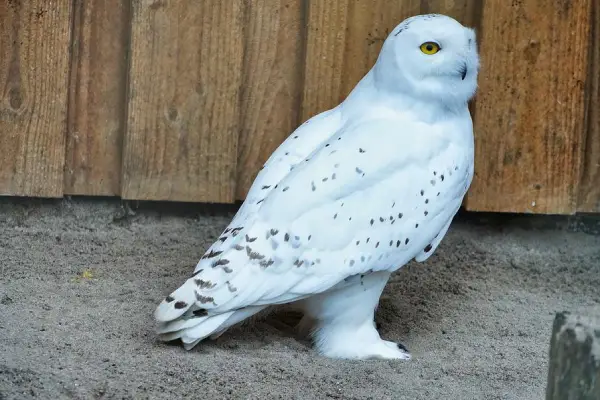
- Scientific Name: Bubo scandiacus
- Length: 21-28 in
- Wingspan: 45-72 in
- Weight: 2.9-6.5 lb
Snowy owls are enormous white birds that rank among the largest owls in the world.
They are the only white owls in the world.
Snowy owls have extremely large yellow eyes that are around 0.92 inches in diameter – this is slightly smaller compared to great horned and Eurasian eagle-owls but bigger compared to great gray owls.
Snowy owls sleep at night, hunt during the day, and have a diet that includes small mammals, some water birds, fish, and even carrion.
Their favorite food is lemmings (small mouselike rodents) – snowy owls might hunt as much as 1,600 of those per year. These beautiful birds are monogamous and mate for life.
Snowy owls are just one of many white-colored birds of prey – check out the full list here.
Great Gray Owl
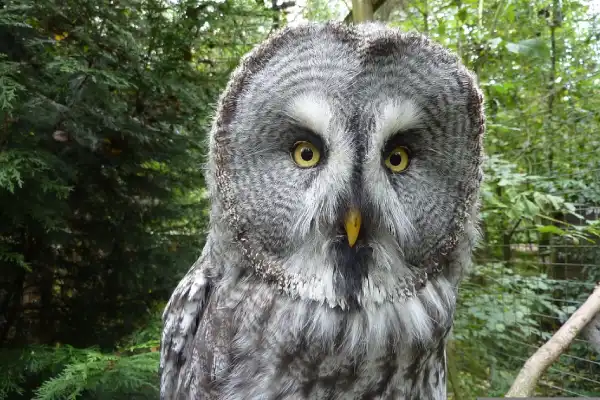
- Scientific Name: Strix nebulosa
- Length: 24-33 in
- Wingspan: 56-60 in
- Weight: 1.2-4 lb
Great gray owls are the largest species of owls in the world by length.
They are known under several names, including Phantoms of the North, bearded owls, sooty owls, etc. They are found in Europe, Asia, and North America, usually around coniferous forests, meadows, and bogs.
Great gray owls have forward-facing eyes on their large round heads. The eyes have yellow-colored irises with darker circles around them.
Great gray owls are a very rare species that hunt around dusk and dawn, mostly on voles.
Although mostly silent, solitary, and stealthy, these raptors have been known to drive off predators as large as black bears when defending their nests.
Eurasian Pygmy Owl
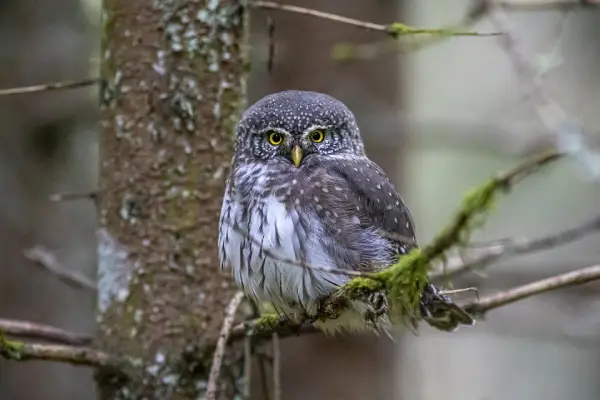
- Scientific Name: Glaucidium passerinum
- Length: 6-7.5 in
- Wingspan: 13.8 in
- Weight: 1.7-2.7 in
Eurasian pygmy owls are the smallest owl species in Europe.
They have reddish-brown plumage with dots, white eyebrows, and fine spotting on their crowns.
Eurasian pygmy owls also have staring golden eyes that look huge compared to their tiny heads.
These birds of prey are common in mixed and coniferous forests where they are most active during dusk and dawn (crepuscular animals). Eurasian pygmy owls feed on voles, bats, lemmings, mice, small birds, lizards, fish, and insects – they will store their food and use it during winter.
Read More: Bird species with eyebrows on their heads
Spotted Eagle-owl
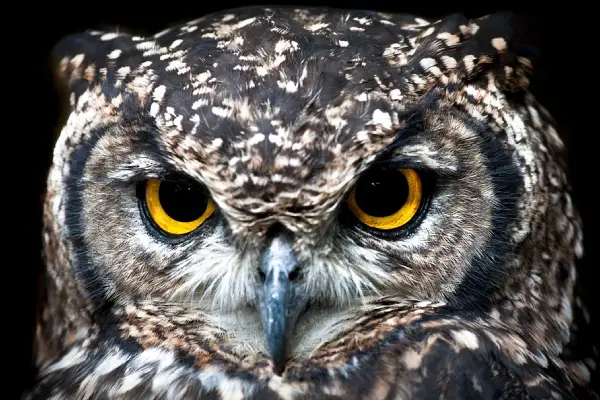
- Scientific Name: Bubo africanus
- Length: 18 in
- Wingspan: 39-55 in
- Weight: 1-2 lb
Spotted eagle-owls are the most common owl species of southern Africa, found in different habitats, including open scrubs, grasslands, forest edges, and others.
These large, gray-brown raptors have long ear tufts and brown plumage; their most common call is a soft booming sound that resembles “who-are-you“.
Spotted eagle-owls are known for their mesmerizing bright yellow eyes.
They hunt rodents, birds, insects, small mammals, and reptiles, often swallowing their prey whole.
Short-eared Owl

- Scientific Name: Asio flammeus
- Length: 13-17 in
- Wingspan: 33-43 in
- Weight: 7.3-16.8 oz
Short-eared owls are found on all continents except Antarctica and Australia, making them one of the most widespread bird species.
These medium-sized owls have mottled brown upperparts, whitish underparts, very short ear tufts, and black beaks.
Short-eared owls have large yellow eyes that are accentuated by black rings, making them look like they are wearing mascara!
Although mostly silent, short-eared owls will make a series of “voo-hoo-hoo” calls during the breeding season. They are found in the open country, around marshes, grasslands, montane forests, tundras, and savannas.
Short-eared owls are migratory birds that feed mostly on voles, rats, bats, mice, squirrels, rabbits, and some birds.
Fun Fact: Short-eared owls will often harass falcons, herons, and eagles, just for fun!
Long-eared Owl
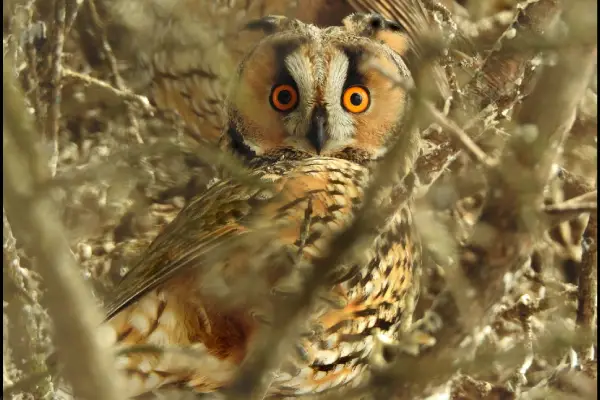
- Scientific Name: Asio otus
- Length: 12-16 in
- Wingspan: 34-40 in
- Weight: 9-15 oz
Long-eared owls are found in North America, Europe, Asia, and Africa.
Also known as northern long-eared owls, lesser horned owls, or cat owls, these medium-sized owls with long ear tufts and big eyes inhabit brushy thickets, conifer groves, and semi-open areas.
North American long-eared owls have yellow eyes, while their Eurasian counterparts have reddish ones.
Males can be extremely vocal and emit hoots that can be heard from over half a mile away.
They are specialized hunters, focusing entirely on small rodents. In Japan, they primarily consume Japanese grass voles, gray red-backed voles, and house mice.
They are also one of the only 12 owl species found in Japan.
Spectacled Owl

- Scientific Name: Pulsatrix perspicillata
- Length: 16-20.6 in
- Wingspan: 33 in
- Weight: 1-2.7 lb
Spectacled owls are large and unmistakable birds found in Central and South America. They are common in humid evergreen forests, often staying hidden in shady spots.
They are brown-black above and buff-colored under – spectacled owls also have light lines around their large bright orange-yellow eyes that look like “spectacles”.
Their call consists of a series of deep hoots that is described as “a sheet of metal being flexed quickly”.
Want to see how many of these owl species would look like with blue eyes? Check this article.
Cape Eagle-owl
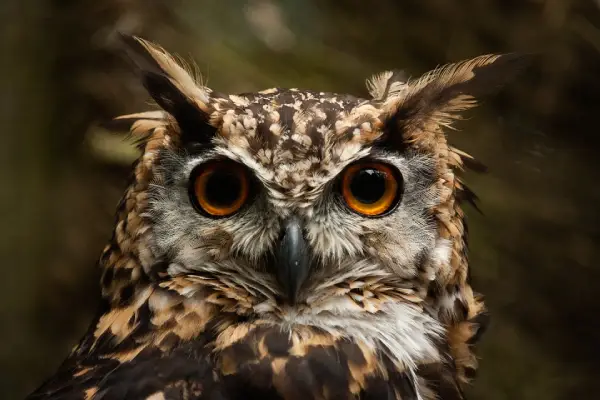
- Scientific Name: Bubo capensis
- Length: 18-24 in
- Wingspan: 48 in
- Weight: 2-4 lb
Cape eagle-owls are large owls with strong-looking builds found in South Africa where they inhabit rocky terrains, mostly mountains.
They resemble spotted eagle-owls and can be identified by their dark brown plumage, prominent ear tufts, and striking yellowish-orange eyes.
Cape eagle-owls have a song that consists of a strong “hoot” that is followed by a weaker “bowh-hu“.
Read More: List of owls that have yellow eyes
Summary
This concludes our list of owls with big eyes.
Examples include snowy owls, burrowing owls, great horned owls, and many others.
Owls have big eyes so they can better adapt to low light conditions since most of them are nocturnal – their eyes are elongated tubes that are held in place by bony structures called sclerotic rings.
And if you enjoyed our article, here are our other popular reads on birds: Stunning photos of over 40 orange-billed birds and Stunning photos of brown owls